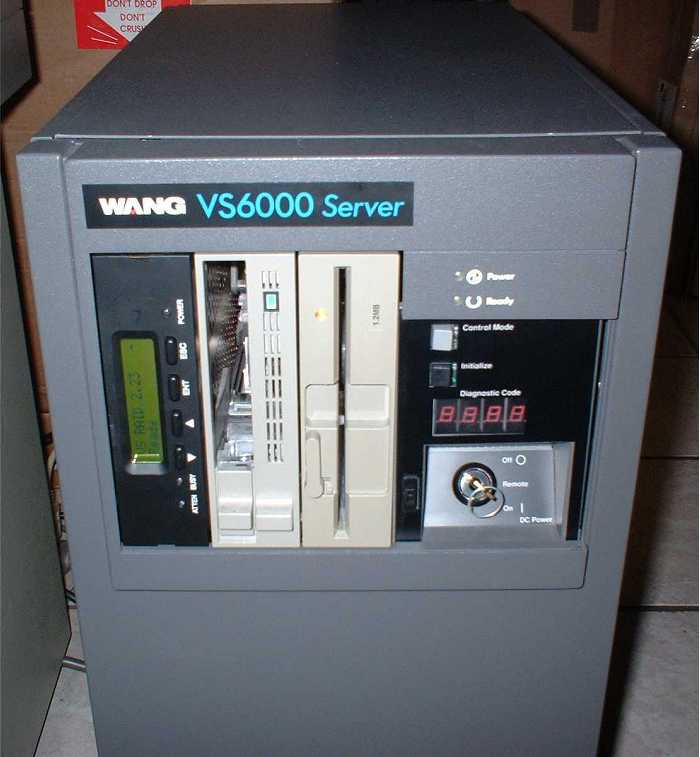My VS system

VS Model Specs and Official Wang Performance Benchmarks
Performance ratings, system/memory/IO bus widths, year of introduction
The Unofficial VS Benchmark Project 
You may be able to help develop measures of how VS models stack up against other current computer systems
FLASH BULLETIN
I now have a good idea of VS performance compared to IBM RS/6000 and HP-9000 performance. I’ve tested eleven different systems using a comparable benchmark program in all cases. The results are, well, more than a little surprising. Contact me by email if you would like to know more about this. The rest of this page (below) is effectively obsolete.
Background and Invitation
You will find the FAST ratings very instructive if you are new to the VS, and useful if you already know the VS well. If your job brought with it the responsibility for an overloaded VS65 or VS7310, you may be surprised to see how many models exist higher on the scale than yours. An overloaded system is a candidate for upgrade. An astonishing number of people who have contacted me in the last 2-1/2 years had no idea that faster models are available, or even that Wang is still in business.
Wang’s FAST ratings for virtually all VS processors in the known universe are available here. I have found them to be good indicators of the performance we can expect from a processor upgrade. They are, of course, relative performance ratings, which gives us a picture of how VS models relate to each other, but no idea of how they relate to other, non-Wang processors. I do not yet have a solution for this, but that is why I brought it up. [Note: I do now have the solution, and some numbers. 01Feb01]
I would like to develop comparitive benchmarks to measure VS systems against non-VS systems. Anyone who has programming access to platforms such as RS/6000, AS/400, DEC Alpha/VMS or Alpha/unix, IBM mainframes, even various models of Intel PC and other current machines can help. See The Unofficial VS Benchmark Project. [updated on 07Feb01]
Early VS models were rated by Wang according to the number of users they could support. That worked, especially at a time when the range of program sizes and processing loads were more limited than they have since grown to be. Configuration limits were not generally imposed by the GENEDIT utility, so if a customer filled out or exceeded a 32-user system and noticed response times correspondingly degraded, everyone was in general agreement that a 64-user system might be in order. Comparitive benchmark ratings were not available from Wang but their absence didn’t seem to concern anyone. Things have changed.
Since the late 1980’s, certainly during the 1990’s, the range of potential program sizes and the processing loads they may impose on a VS has expanded significantly. Small, simple COBOL programs still exist, but so do large PACE database applications. Oracle and FOCUS even had their day on the VS, and those could not be called CPU-friendly software systems. Today, the same VS processor with the same number of users could be one customer’s star performer and another’s barking dog. Accordingly, it is now very helpful to know something about the performance of VS models, and Wang has accomodated that need.
Wang measures each processor with a mix of benchmark programs and computes a number they call the FAST rating (I have the meaning of the acronym somewhere, but if I look for it I’ll never finish writing this). The FAST rating expresses raw computational speed, but tempers it with considerations based on “real” mixes of instructions and I/O. Thus, a model with raw processor speed of twice another processor based in part on the effect of its on-board processor cache (L1, to Intel hounds) might have less than twice the FAST rating because, in real life, real programs do not run entirely from processor cache. Wang is also careful to point out that FAST ratings in no way directly reveal how processor speed may affect individual applications. A simple report, for example, that does little more than read a file and print it may run at about the same speed on a wide range of processors because it will be disk-bound, not processor-bound. A mix of 20 or 50 such programs, though, will almost certainly run appreciably faster on a higher-rated processor, particularly if the files involved are spread across a number of volumes.
